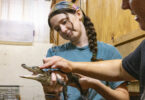A long-term study investigating how altering nutrient inputs to streams affects forest-dwelling organisms has yielded surprising results.
In a paper published in the Online First edition of the journal Oecologia, researchers at UGA have shown that although nutrient enrichment led to increased production of aquatic insects, streamside predators that depend upon them as a food source did not benefit. In fact, they received significantly less nutrition from aquatic sources than did their counterparts at a similar untreated stream nearby.
The study grew out of a five-year experiment led by Amy Rosemond, an associate professor in the Odum School of Ecology, at the Coweeta Hydrological Laboratory in North Carolina. Rosemond and her colleagues selected two streams with similar characteristics and for five years continuously added nitrogen and phosphorus to one of them.
“Nutrient enrichment is the most ubiquitous threat to stream ecosystems,” said Rosemond, explaining that land uses such as development and agriculture often inadvertently introduce nutrients to streams through storm water runoff. “It’s critical that we learn all we can about how ecosystems respond.”
Lead author John Davis, who received his Ph.D. from the ecology school in 2009 and is currently a postdoctoral researcher at Idaho State University, had found in an earlier study that many aquatic insects living in the treated stream became more productive under the influence of the added nutrients. Larger-bodied insects, in particular, thrived, growing to their maximum size and becoming the most populous of the stream’s insects.
The earlier study showed that in-stream predators were generally unable to consume these larger insects. The researchers predicted that terrestrial predators such as spiders would be able to take advantage of this increased source of nutrition. Certain spiders rely heavily on aquatic insects for food, and the team expected that their numbers would increase with access to more prey.
The team sampled for aquatic insects and spiders in the late spring. They analyzed for population abundance, size and source of nutrition. To determine how much of the spiders’ diet was from aquatic sources, the researchers had added a stable isotope tracer to both the treated and reference streams, allowing them to track the spiders’ sources of nitrogen.
“We didn’t expect what we found,” said Rosemond.
Most spiders—even those that specialize in preying on stream insects—were receiving less nutrition from aquatic sources at the enriched stream than were those at the untreated stream. And rather than increasing, populations of spiders were the same or smaller at the treated stream than at the reference stream.
The researchers suspect that, as with in-stream predators, the physical characteristics of aquatic insects were a problem for the spiders. The most abundant of the insects in the treated stream were large bodied and therefore difficult for the spiders to consume. They also had wing hairs that made them better able to escape being caught in spiders’ webs. Spiders were not able to take advantage of the increased availability of nutrients because it was not in a form that was easily accessible to them.
The study’s other co-author was Gaston “Chip” Small, who received his Ph.D. from the Odum School in 2010 and is now a postdoctoral associate at the University of Minnesota.







